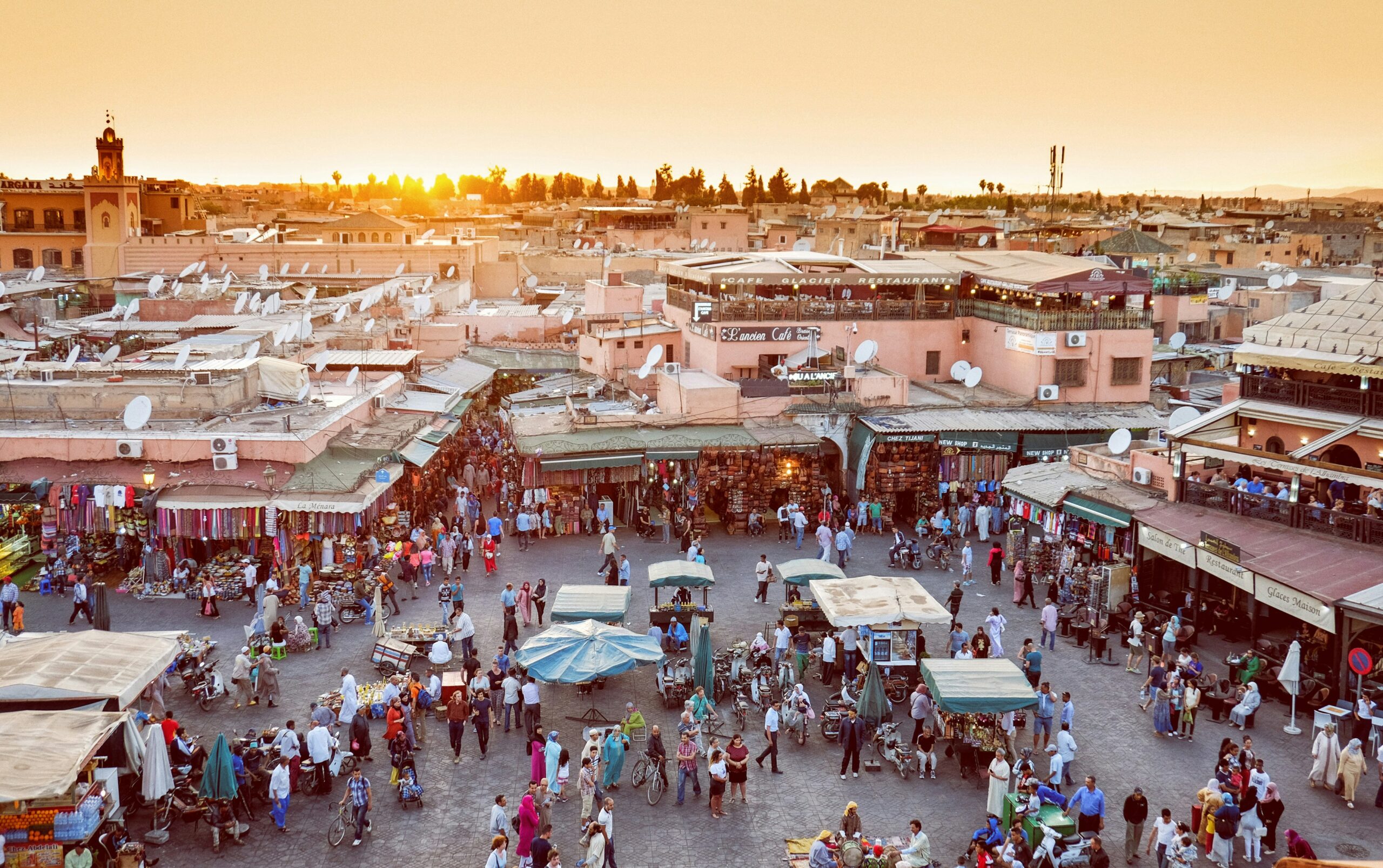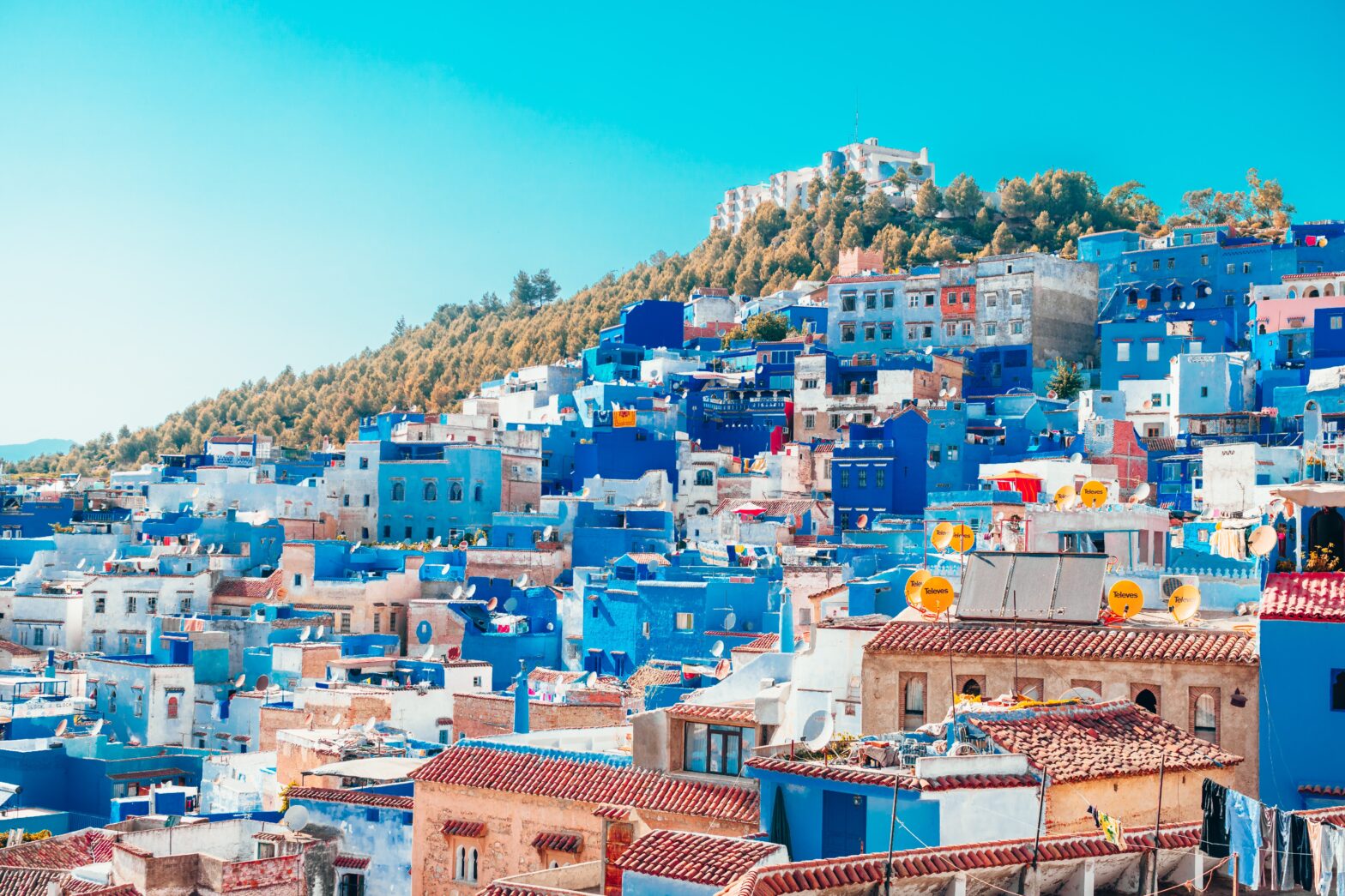The Kingdom of Morocco is a stunning destination that has been featured in countless films. The North African country has Arabian, Berber and European influences, which are uniquely represented both aesthetically and culturally. Due to Morocco’s geographical location, where Africa, the Middle East and Europe meet, it is a country with a diverse ethnic makeup. On the other hand, Morocco is a thriving cultural hub that has an interesting history, sustains the art of natural dyeing, has preserved historical sites and a natural landscape that amazes.
Some of the most popular attractions and features of Morocco have to do with its natural beauty, rich cuisine and architectural gems. Desert tours are a popular activity for tourists that want to experience one of the most famous attractions of this part of the world, the Sahara Desert. To survey the Berber nomadic culture, travelers can take treks with camels across the desert and even see the breathtaking star-studded night sky while journeying through the sand dunes. Morocco has a diverse landscape that includes the Atlas Mountains, Sahara Desert, Draa Valley, Todra Gorge and sandy coasts (along with many more unique landscapes). In order to observe as much of Morocco as possible, tourists can even book a ride in a hot air balloon to get an aerial view.
The cuisine and architecture of Morocco are some of its quite popular aspects. In such a melting pot of ethnicities, it is no surprise that some of Morocco’s rich culture has trickled into the delectable food selections. Couscous, the national dish, is one of the most popular Moroccan dishes that tourists may notice is a staple of meals on a weekly basis. Shakshuka is another popular dish that is derived from Berber culture. Tourists can enjoy the elevated omelet-like dish at local spots to fuel them for the day ahead. After indulging in some traditional Moroccan dishes tourists should make their way to buildings that have both historical and architectural significance. The Ksar of Aït Benhaddou, Medina of Fes and Medina of Marrakesh (Bahia Palace) are ancient and breathtaking structures that tourists can see while in Morocco.
While all of these enticing attractions can make for an unforgettable trip to Africa, travelers may question the safety level of Morocco. Since Africa is an expansive continent, safety levels can vary wildly from region to region. Even bordering countries can provide contrasting experiences for travelers, so it is important to keep up with the cultural climate of potential destinations. For world travelers who want to stay informed and safe, we have compiled the most important information on Morocco.
Best Travel Advisories

Travelers can find up to date information about the safety levels of potential travel destinations on several different platforms. To assess the health and safety threats of locations abroad, travelers should be sure to utilize accredited travel advisories. Here are some of the leading advisories for concerned travelers.
There are some government organizations that monitor the safety of global destinations. The U.S. Department of State and the Central Intelligence Agency (CIA) are two organizations that provide valuable information for travelers. The Department of State’s travel advisory categorizes Morocco as a level two destination. This means that travelers should exercise increased caution when traveling there. This alert is justified by the potential threats of political unrest and terrorist group attacks. Due to the nature of terrorist attacks, which target transportation hubs and tourist locations, tourists should stay alert.
While these attacks are not very common, they are possible which means that the situation (and safety category) may change at a moment’s notice. Through the CIA’s website tourists will find tips and travel information that will help them feel more comfortable in Morocco, including ways to respect the local culture. In general though it is recommended that travelers avoid political demonstrations, have a plan for emergencies, know the location of the U.S. Embassies and Consulates and exercise normal personal safety precautions.
The Centers for Disease Control and Prevention (CDC) and World Health Organization (WHO) are great resources for travelers that want to assess the health threats of potential travel destinations. The CDC provides travel health notices and keeps up to date information on local illnesses, medicines and even preventative care that travelers should know. From environmental threats like unfamiliar bugs that bite to how to access medical care while abroad and even travel aftercare, the CDC is one of the top platforms that helps travelers secure their personal safety. WHO has website pages dedicated to particular countries with health statistics and travel advice. Here tourists can check in on the health and wellbeing of the Moroccan people before making their own decision on if they are comfortable traveling there.
Is Morocco Safe for Tourists and Solo Travelers?

While Morocco is considered a relatively safe place to visit, it has its own safety concerns. The countries’ overall crime index has been moderate over recent years, which means that it does not pose a significant threat to travelers. But it is important to note that crime is more serious in populated areas like tourist destinations and major cities. The highly reported crime includes petty theft and harassment towards women. Pick pocketing and purse snatching are among the most common types of theft. Women are typically safe in Morocco, but solo travelers that are women should take extra precautions to ensure their safety.
How to Stay Safe in Morocco

Travelers should be sure to exercise regular travel precautions when going abroad. These precautions include, but are not limited to, securing personal belongings, not flaunting expensive things, avoiding walking in isolated or poorly lit areas and staying alert while in public spaces. Other than those, there are some local customs to be observant of so that tourists are considered respectful of the culture. Something to be conscious of, especially for women travelers, is the cultural norms of modesty in public spaces. While there is not necessarily a dress code, to avoid unwanted attention and respect local sensibilities it is advisable to avoid revealing clothing. Of course, these standards vary by location and there are plenty of situational nuances that apply.
Transportation safety is an important element to secure travel, especially those that plan to rely on public transportation. For those travelers, there is a railroad network in Morocco that can transport travelers. It can help get tourists around the northern side of Morocco as well as Marrakesh and the coast. There is a bus system as well that goes from the larger to smaller cities, which is convenient for travelers without a car. For more complex or specific locations, a taxi is the go to mode of transportation. But the precautions on all the popular types of public transport in Morocco are generally the same. Passengers should secure their luggage or personal belongings, confirm their driver’s certification or affiliation, try to avoid riding public transport alone at night and do not fall asleep while in open public areas.
Where to Stay in Morocco
There are a few recommended areas to stay in for travelers of Morocco. Marrakesh Palmeraie, Marrakesh Medina and Rabat are all popular areas. Rabat is actually the capital of Morocco and a UNESCO World Heritage Site known for its popular landmarks. The urban area actually has a lower crime rate than many other cities in the country. Rabat offers both luxury and budget accommodations. Euphoriad is a popular, luxury riad (like a lavish guesthouse) in a good area of Rabat.
The Marrakesh Medina is one of the best areas for tourists overall since it has central attractions, a nearby souk (shopping marketplace with stalls) and is surrounded by beautiful nature. The area has traditional hotels, apartments, and riads available to travelers. Marrakesh Palmeraie offers a bit of a different experience to its guests. It has a relaxing atmosphere that is supplemented by the laid-back feel. Palmeraie is a great place to kick back and relax, it even has many luxury resorts that feature private villas, golf clubs and world-class amenities. Each of these areas offers its own unique experience of Morocco but is considered a safe and comfortable space for tourists to stay in.
Best Time to Visit Morocco
Morocco’s weather is a primary concern for travelers since it is in a hot region. Due to the generally consistent temperatures, Morocco is a destination that can be visited year-round comfortably. Most travelers prefer to visit this destination around Spring or Autumn. With average temperatures of 70 or 80 degrees, it is no surprise that travelers usually plan their trip to Morocco during the milder feeling months. Either between September to November and March to April travelers will notice the most refreshing temperatures. Springtime also has the most affordable flight and accommodation prices.
People Also Ask
Are Moroccans friendly to tourists? Yes, Moroccans are welcoming. Although some try to take advantage of unsuspecting tourists, much like in any other destination.
What is the safest city in Morocco? Marrakesh is one of the safest cities in the country for tourists.
